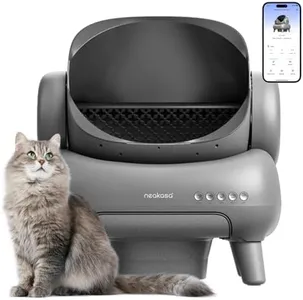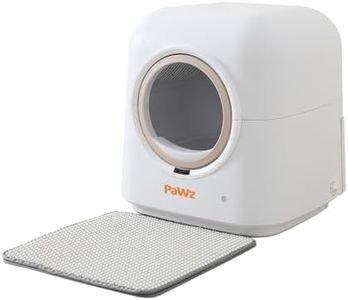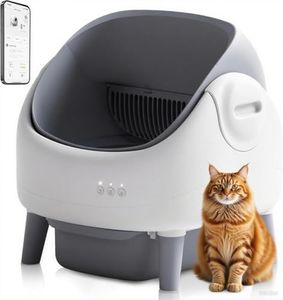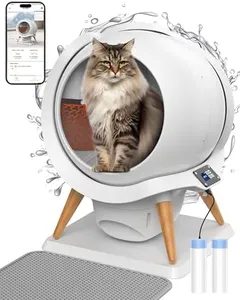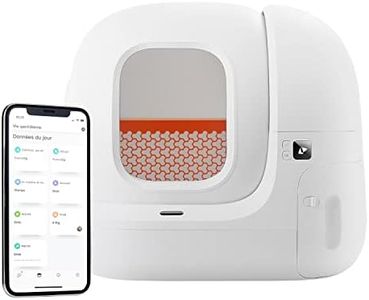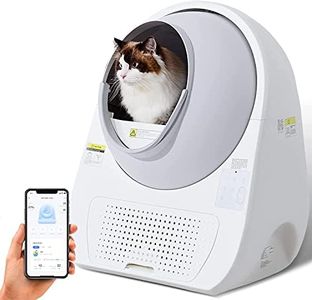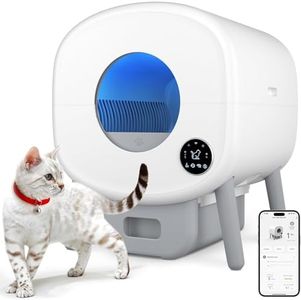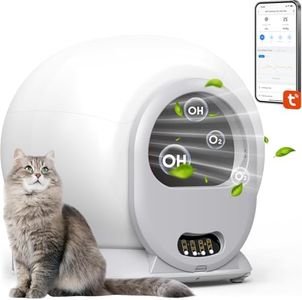We Use CookiesWe use cookies to enhance the security, performance,
functionality and for analytical and promotional activities. By continuing to browse this site you
are agreeing to our privacy policy
10 Best Self Cleaning Litter Boxes For Cats
From leading brands and best sellers available on the web.Recommended lists
Buying Guide for the Best Self Cleaning Litter Boxes For Cats
Choosing a self-cleaning litter box for your cat can make life much easier by reducing the time and effort needed to keep your cat’s litter area tidy. To ensure you pick the right one, think about your cat's needs, how many cats you have, where you plan to place the box, and what will be convenient for your daily routine. Every home and cat is different, so focus on the features that will fit your unique situation best.Cleaning MechanismThe cleaning mechanism in self-cleaning litter boxes is the way the box removes waste automatically. It can use raking arms, rotating sieves, or flushing systems to separate waste from clean litter. This is important because the efficiency and reliability of the cleaning method will affect how clean the box stays and how much manual effort you save. Simple rake systems are usually straightforward but may struggle with clumps breaking apart, while rotation or flushing methods can provide a deeper clean but may have more parts to maintain. If you want minimal interaction, choose a model with a highly automated and thorough mechanism. If you are fine with some occasional manual assistance, a simpler system could be enough.
Litter CompatibilityLitter compatibility refers to the types of cat litter a box can use, such as clumping clay, crystals, or biodegradable types. This is crucial because using the wrong kind of litter can cause malfunction or reduce cleaning effectiveness. Most boxes have recommended or required litter types—some are very specific, while others are more flexible. If you or your cat have a preference or sensitivity to certain litters, make sure the box works with them. If you want to keep costs or odors down, look for models that accept affordable or specialty litters that suit your goals.
Waste Storage CapacityWaste storage capacity is the size of the compartment that holds waste before it needs to be emptied. A larger capacity means you won’t need to empty it as frequently, which is especially helpful if you have multiple cats or travel often. Smaller compartments need more regular attention but can keep the overall box more compact. If you have more than one cat, go for higher capacity; for single-cat households or when space is tight, a smaller bin could suffice.
Size and Entry DesignThe size and entry design determine how easily your cat can access the litter box and how much space the box takes up in your home. Entry style could be top, front, or side, and the overall size needs to fit both your cat's comfort and your placement options. If you have large or elderly cats, look for low-entry or roomy designs. For limited floor space or privacy, compact or top-entry models could work better. Always ensure your kitty can get in and move around comfortably.
Noise LevelNoise level describes how loud the self-cleaning process is. Some systems make mechanical sounds that could startle sensitive cats or disrupt your household, especially if the box is near living or sleeping areas. If your cat is easily scared, or if you’re sensitive to noise, a quieter model or one that cleans at scheduled times is better. If the box will be in a garage or laundry room, noise may matter less.
Ease of Cleaning and MaintenanceEase of cleaning and maintenance covers how simple it is to take the box apart, wash components, and keep the system running smoothly. Self-cleaning parts can reduce daily scooping, but occasional thorough cleaning is still necessary. Check how easy it is to reach waste compartments, clean sensors, or replace filters. If you want minimal maintenance, choose a design with fewer nooks and simple assembly. If you’re fine with a few extra steps for better performance, more complex models can be worthwhile.
Power SourceThe power source tells you whether the box needs to be plugged in or is battery operated. This matters for where you can place the box and reliability during power outages. Plug-in models tend to offer stronger performance but need to be near an outlet; battery-powered or manual-assisted varieties offer flexibility for placement and are useful if outlets are scarce or your box might be moved.
Odor ControlOdor control refers to features, like carbon filters or sealed waste compartments, that help contain and reduce unpleasant smells. Good odor control is important for homes with multiple cats or if the litter box is in a central area. Some designs have advanced solutions, while others rely mainly on the litter and simple covers. If you’re sensitive to smells or want the box in a visible spot, prioritize models with enhanced odor control systems.
